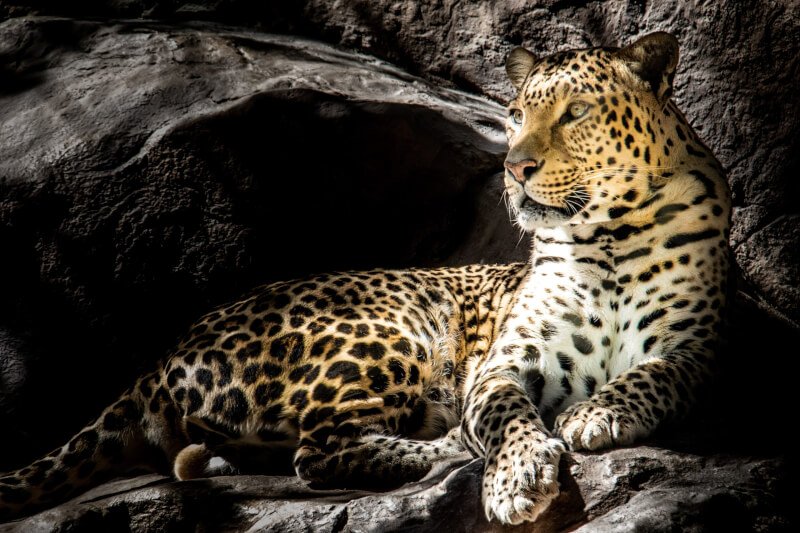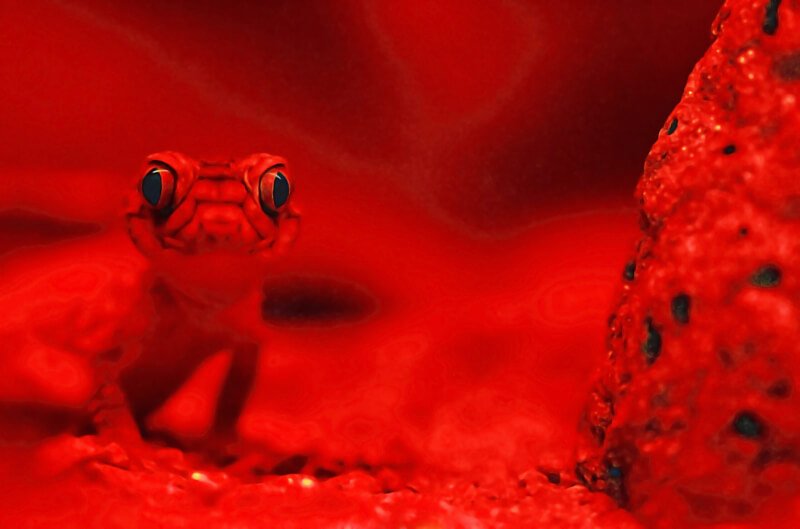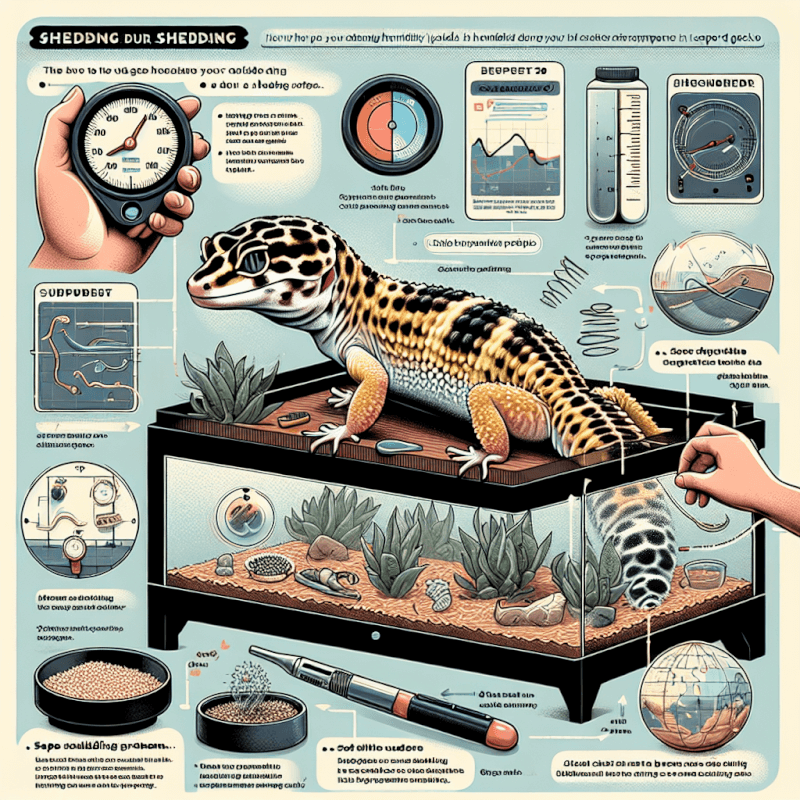Are you a proud owner of a leopard gecko, but find yourself perplexed by their shedding problems? Well, fret not, because in this article, we will guide you through some helpful tips and tricks on how to handle shedding problems in your beloved leopard gecko. From understanding the shedding process to providing the right conditions and assistance, we’ve got you covered. So, if you want to ensure a smooth and hassle-free shedding experience for your gecko, keep reading!
Common Causes of Shedding Problems
Inadequate humidity levels
One common cause of shedding problems in leopard geckos is inadequate humidity levels in their enclosure. Leopard geckos require a certain level of humidity to properly shed their skin. If the humidity is too low, the old skin can become dry and stick to the gecko, leading to incomplete shedding or a stuck shed. It is important to ensure that the humidity levels in the enclosure are appropriate for your gecko’s needs.
Improper diet
Another factor that can contribute to shedding problems is an improper diet. Leopard geckos require a varied and balanced diet to maintain their overall health and proper shedding. If their diet lacks essential nutrients, it can lead to issues with shedding. It is crucial to provide your gecko with a diet that includes a variety of live insects and, occasionally, a calcium and vitamin supplement.
Skin infections or parasites
Skin infections or parasites can also cause shedding problems in leopard geckos. These infections can lead to skin inflammation, irritation, or even open sores, making it difficult for the gecko to shed properly. It is important to regularly check your gecko’s skin for any signs of infection or parasites and seek veterinary treatment if necessary.
Lack of proper shedding surfaces
Leopard geckos need proper shedding surfaces in their enclosure to facilitate the shedding process. Without these surfaces, such as rocks or branches, the gecko may struggle to remove their old skin effectively. It is essential to provide multiple shedding surfaces in the enclosure to ensure that your gecko has ample opportunities to shed completely.
Signs of Shedding Problems
Incomplete shedding
One of the most common signs of shedding problems in leopard geckos is incomplete shedding. If you notice patches of old skin remaining on your gecko after shedding, it indicates that the shedding process was not successful. Incomplete shedding can be caused by various factors, including inadequate humidity or a lack of proper shedding surfaces.
Stuck shed
A stuck shed refers to when the old skin does not come off completely and becomes stuck on certain areas of the gecko’s body. This can happen if the humidity levels are too low or if the gecko has limited access to proper shedding surfaces. A stuck shed can cause discomfort and even lead to infections if left untreated.
Loss of appetite
Shedding problems can also manifest in a loss of appetite in leopard geckos. During shedding, geckos may experience discomfort or irritation, which can result in a temporary loss of appetite. If your gecko shows a decreased interest in food during the shedding process, it is essential to monitor their weight and consult with a veterinarian if the behavior persists.
Lethargy
Shedding can be a physically demanding process for leopard geckos, and it is not uncommon for them to display lethargic behavior during this time. Your gecko may appear less active, spend more time hiding, or seem generally uninterested in their surroundings. However, it is crucial to monitor their energy levels and ensure that they are still taking in sufficient water during this period.
Skin redness or irritation
Skin redness or irritation is another sign of shedding problems. This can indicate that the gecko’s skin is inflamed or irritated, potentially due to an infection or the presence of parasites. It is important to closely examine your gecko’s skin and seek veterinary advice if you notice any redness, swelling, or signs of discomfort.

Preventive Measures
Maintaining proper humidity levels
To prevent shedding problems in leopard geckos, it is crucial to maintain appropriate humidity levels in their enclosure. The recommended humidity range for leopard geckos is around 30-40%. This can be achieved by misting the enclosure with water or using a reptile humidifier. Monitoring the humidity levels with a hygrometer is essential to ensure they are within the appropriate range.
Providing a varied and balanced diet
A key preventive measure against shedding problems is providing a varied and balanced diet for your leopard gecko. Their diet should consist primarily of live insects, such as crickets or mealworms, and occasionally supplemented with calcium and vitamin powder. Offering different insect species and occasionally introducing other food items like waxworms or phoenix worms can help ensure they receive all necessary nutrients.
Regularly cleaning the enclosure
Regularly cleaning the gecko’s enclosure is essential to prevent shedding problems. A clean environment helps maintain good hygiene and reduces the risk of infections or parasites that could interfere with the shedding process. Cleaning should involve removing any waste, old substrate, or uneaten food, and regularly disinfecting the enclosure to prevent the buildup of harmful bacteria.
Offering multiple shedding surfaces
To facilitate proper shedding, it is important to provide multiple shedding surfaces in the gecko’s enclosure. These can include rocks, branches, or even commercially available reptile shedding aids. The surfaces should be placed in different locations within the enclosure to give the gecko options for shedding. Having various textures and sizes can also help ensure complete shedding.
Handling Incomplete Shedding
Preparing a humidity chamber
If your leopard gecko experiences incomplete shedding, you can create a humidity chamber to help facilitate the process. A humidity chamber can be made by placing a small container, such as a plastic box or a reptile hide, with damp moss or paper towels inside the gecko’s enclosure. The gecko can enter the chamber, and the increased humidity will help moisten the unshed skin, making it easier to remove.
Gently removing stuck shed
If there are specific areas of stuck shed, you can try gently removing it yourself. Start by moistening the area with warm water or using a reptile-safe shedding aid. Then, using clean and gentle movements, try to peel away the stuck shed. Be careful not to pull forcefully or injure the gecko’s delicate skin. If you encounter resistance or the gecko seems uncomfortable, it is best to consult a veterinarian.
Assisting with eye shedding
Leopard geckos may sometimes experience difficulty in shedding the skin around their eyes. If you notice that the gecko has eye caps or the skin around the eyes is not shedding properly, do not attempt to remove it yourself. Instead, seek veterinary assistance. They will be able to safely assist with the removal of eye caps or provide the necessary treatment for any eye-related shedding issues.
Monitoring for signs of infection
During the shedding process, it is important to monitor your gecko for any signs of infection. If you notice redness, swelling, open sores, or signs of discomfort, it could indicate an infection. In such cases, it is crucial to seek veterinary attention promptly. Skin infections can worsen quickly and may require appropriate treatment, such as antibiotics or antifungal medication.

Dealing with Stuck Shed
Soaking the gecko in a shallow warm bath
If your leopard gecko has a stuck shed, one effective way to help loosen it is to soak them in a shallow warm bath. Prepare a container with lukewarm water that is deep enough to cover the gecko’s body but not deep enough for them to drown. Allow the gecko to soak for around 15-20 minutes. The moisture will help soften the stuck shed, making it easier to remove.
Using a moist cotton swab
For smaller or more delicate areas of stuck shed, you can use a moist cotton swab to gently rub the area. Dip the cotton swab in water or a reptile-safe shedding aid to help moisten the stuck shed. Use gentle circular motions to rub the area and encourage the shed to come off. Take care not to apply excessive pressure or cause any discomfort to the gecko.
Providing a humid hide box
Another way to address stuck shed is to provide a humid hide box in the gecko’s enclosure. A humid hide box can be created by placing damp moss or paper towels inside a hide or small container. The gecko can enter the hide box, and the increased humidity will help moisten the stuck shed, making it easier to remove. Ensure that the hide box is easily accessible and large enough for the gecko to comfortably enter.
Seeking veterinary assistance if necessary
If the stuck shed persists or if you are uncomfortable attempting to remove it yourself, it is best to seek veterinary assistance. A vet experienced in reptile care will be able to safely and effectively address the issue. They may use specialized techniques or recommend appropriate treatments to help your gecko shed properly.
Addressing Loss of Appetite and Lethargy
Evaluating the gecko’s environment and diet
If your leopard gecko shows a loss of appetite and lethargy during shedding, it is important to evaluate their environment and diet. Ensure that the temperature gradient in the enclosure is appropriate, with a warm side and cool side. Check the humidity levels and make any necessary adjustments to ensure they are within the recommended range. Additionally, review your gecko’s diet and make sure it is varied, balanced, and meets their nutritional needs.
Ensuring proper temperature gradient
Leopard geckos rely on a proper temperature gradient to maintain their overall health and digestive processes. During shedding, it is crucial to ensure that the gecko’s enclosure provides a suitable temperature gradient. The warm side of the enclosure should have a temperature of around 88-90°F (31-32°C), while the cool side should be around 75-80°F (24-27°C). Providing the gecko with a temperature gradient will help them regulate their body temperature and support their appetite.
Offering favorite foods
If your gecko is experiencing a loss of appetite during shedding, it can be helpful to offer their favorite foods. Some geckos may show more interest in certain insects or specific food items. By providing their preferred foods, you may encourage them to eat and maintain their nutritional intake even during the shedding process.
Seeking veterinary advice
If your leopard gecko’s loss of appetite or lethargy persists or worsens, it is advisable to seek veterinary advice. A veterinarian familiar with reptile care can examine your gecko and provide guidance on any underlying health issues. They may recommend further diagnostic tests or suggest appropriate treatments to address the specific concern.

Treating Skin Redness or Irritation
Avoiding handling during shedding
When your leopard gecko is shedding, it is essential to avoid unnecessary handling. Handling during shedding can cause stress and potentially lead to skin redness or irritation. Allow your gecko to complete the shedding process undisturbed to minimize the risk of any additional complications.
Applying a small amount of pure aloe vera gel
If you notice mild skin redness or irritation, you can apply a small amount of pure aloe vera gel to soothe the affected area. Aloe vera has natural anti-inflammatory properties that can help reduce redness and provide relief to the gecko’s skin. Ensure that the aloe vera gel does not contain any added chemicals or fragrances that could be harmful to your gecko.
Using a reptile-safe antibiotic or antifungal cream
For more severe cases of skin redness or irritation, you may consider using a reptile-safe antibiotic or antifungal cream. These creams can help address any underlying infections or irritations that may be contributing to the redness. It is crucial to consult with a veterinarian to ensure the safe and appropriate use of these medications.
Consulting a veterinarian if the condition worsens
If the skin redness or irritation worsens or does not improve with home remedies, it is recommended to consult a veterinarian. They will be able to assess the situation and provide appropriate treatment options. It is important not to wait too long before seeking professional help, as skin conditions can worsen rapidly if left untreated.
Seeking Veterinary Assistance
When shedding problems persist
If you have tried various preventive measures and implemented appropriate interventions but your leopard gecko continues to experience shedding problems, it is advisable to seek veterinary assistance. A veterinarian can examine your gecko, evaluate their overall health, and provide further guidance on potential underlying causes or additional treatment options.
In case of severe stuck shed
If your leopard gecko has a severe stuck shed that you are unable to remove safely, it is essential to seek veterinary assistance promptly. A veterinarian experienced in reptile care can use safe techniques to remove the stuck shed and prevent any further complications. Delaying veterinary assistance may lead to infections or wounds that require more extensive treatment.
If signs of infection are observed
If you notice signs of infection, such as redness, swelling, or discharge, it is crucial to seek veterinary assistance immediately. A veterinarian will be able to evaluate the infection, prescribe appropriate medications, and guide you on how to properly care for your gecko during the treatment process. Prompt intervention can prevent the infection from spreading and causing further harm.
For guidance on appropriate treatments
In situations where you are unsure about the best course of action or require guidance on appropriate treatments, seeking veterinary assistance is highly recommended. A veterinarian with expertise in reptile care can provide you with accurate information and personalized advice based on your gecko’s specific needs. They will help you navigate any challenges related to shedding problems and ensure the best possible outcome for your gecko’s health.

Conclusion
Shedding problems can be common in leopard geckos, but with regular monitoring and preventive measures, they can be effectively managed. Maintaining proper humidity levels, providing a balanced diet, offering shedding surfaces, and regular cleaning of the enclosure are crucial preventive measures. In case of shedding issues, such as incomplete shedding or stuck shed, various techniques like humidity chambers, soaking, and moist cotton swabs, can be used to assist the shedding process. Addressing loss of appetite and lethargy, as well as treating skin redness or irritation, require evaluating the gecko’s environment, offering appropriate temperatures and foods, and seeking veterinary advice when necessary. Lastly, if shedding problems persist, severe stuck shed occurs, signs of infection are observed, or guidance on treatments is needed, it is important to consult a veterinarian. By taking timely intervention and seeking veterinary assistance when needed, you can ensure the well-being of your leopard gecko and address any shedding problems that arise.


